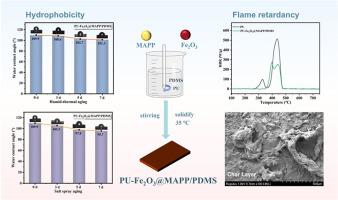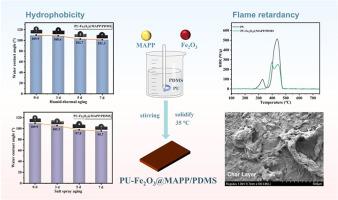Polyurethane coating with PDMS/Fe2O3/microencapsulated APP: Enhanced flame retardancy and aging resistance performance
IF 4.5
2区 化学
Q2 POLYMER SCIENCE
引用次数: 0
Abstract
Cable fireproof coatings are functional materials applied to cable surfaces, designed to form a protective barrier during heating or fire, thereby preventing or slowing flame propagation. This study developed a novel hydrophobic and fireproof coating PU-Fe2O3@MAPP/PDMS, based on polydimethylsiloxane (PDMS), metal oxides (γ-Fe2O3), and microencapsulated ammonium polyphosphate (MAPP). The optimized formulation of PU-Fe2O3@MAPP/PDMS is comprising of 30 wt% PDMS, 1.5 wt% γ-Fe2O3, and 10 wt% MAPP, which demonstrated a peak heat release rate (PHRR) reduction of 46.6 % compared to unmodified polyurethane (PU) coatings, alongside superior hydrophobicity (water contact angle 109.9°). The aging processes led to a deterioration in both flame-retardant and hydrophobic properties for both PU and PU-Fe2O3@MAPP/PDMS coatings. Notably, the PU-Fe2O3@MAPP/PDMS coating demonstrated superior aging resistance, outperforming the unmodified PU in terms of maintaining flame-retardant and hydrophobic functionalities over extended aging periods. Mechanistic studies revealed synergistic effects of PDMS (promoting char formation), γ-Fe2O3 (catalytic flame inhibition), and MAPP (gas-phase radical quenching), alongside enhanced aging resistance due to PDMS's molecular entanglement with the PU matrix. This work provides a scalable strategy for designing multifunctional coatings tailored for harsh cable trench environments.


PDMS/Fe2O3/微胶囊化APP聚氨酯涂料:增强阻燃和耐老化性能
电缆防火涂料是涂在电缆表面的功能材料,用于在加热或着火时形成保护屏障,从而防止或减缓火焰的传播。本研究以聚二甲基硅氧烷(PDMS)、金属氧化物(γ-Fe2O3)和微囊化聚磷酸铵(MAPP)为基料,研制了一种新型疏水防火涂料PU-Fe2O3@MAPP/PDMS。优化后的PU-Fe2O3@MAPP/PDMS配方由30wt%的PDMS、1.5wt%的γ-Fe2O3和10wt%的MAPP组成,与未改性的聚氨酯(PU)涂层相比,峰值热释放率(PHRR)降低了46.6%,同时具有优异的疏水性(水接触角109.9°)。老化过程导致PU和PU-Fe2O3@MAPP/PDMS涂层的阻燃性和疏水性都下降。值得注意的是,PU-Fe2O3@MAPP/PDMS涂层表现出优异的耐老化性能,在延长老化时间内保持阻燃和疏水功能方面优于未改性的PU。机理研究揭示了PDMS(促进炭形成)、γ-Fe2O3(催化火焰抑制)和MAPP(气相自由基淬火)的协同作用,以及PDMS与PU基体的分子纠缠导致的抗老化能力增强。这项工作为设计适合恶劣电缆沟槽环境的多功能涂料提供了一种可扩展的策略。
本文章由计算机程序翻译,如有差异,请以英文原文为准。
求助全文
约1分钟内获得全文
求助全文
来源期刊

Polymer
化学-高分子科学
CiteScore
7.90
自引率
8.70%
发文量
959
审稿时长
32 days
期刊介绍:
Polymer is an interdisciplinary journal dedicated to publishing innovative and significant advances in Polymer Physics, Chemistry and Technology. We welcome submissions on polymer hybrids, nanocomposites, characterisation and self-assembly. Polymer also publishes work on the technological application of polymers in energy and optoelectronics.
The main scope is covered but not limited to the following core areas:
Polymer Materials
Nanocomposites and hybrid nanomaterials
Polymer blends, films, fibres, networks and porous materials
Physical Characterization
Characterisation, modelling and simulation* of molecular and materials properties in bulk, solution, and thin films
Polymer Engineering
Advanced multiscale processing methods
Polymer Synthesis, Modification and Self-assembly
Including designer polymer architectures, mechanisms and kinetics, and supramolecular polymerization
Technological Applications
Polymers for energy generation and storage
Polymer membranes for separation technology
Polymers for opto- and microelectronics.
 求助内容:
求助内容: 应助结果提醒方式:
应助结果提醒方式:


